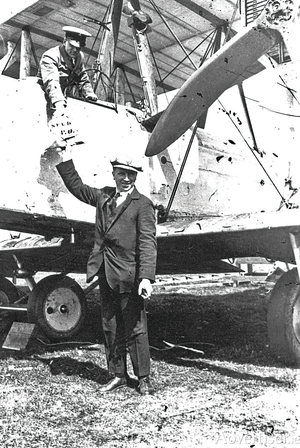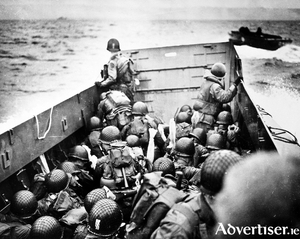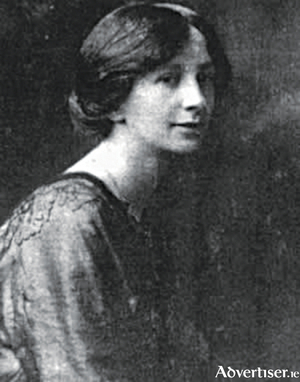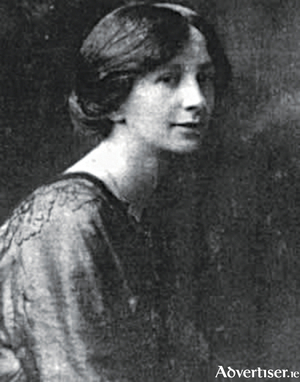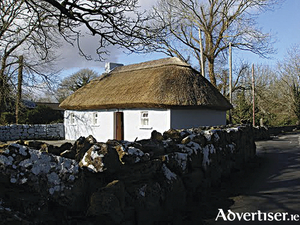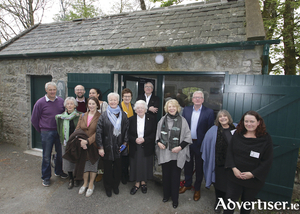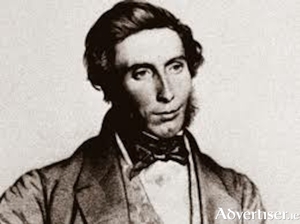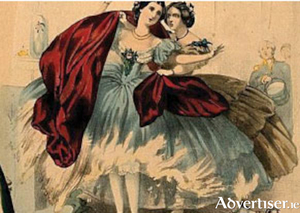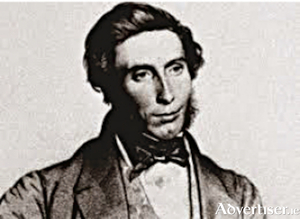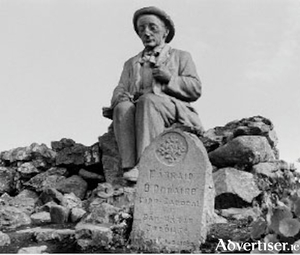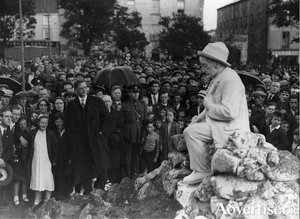Charles Lindberg lands in Paris - heralds new era of air travel
Thu, Jul 04, 2019
Week IV
If Capt J Alcock and Lieut AW Brown were shy public speakers almost to the point of being self-deprecating about their extraordinary achievement of flying the Atlantic in, what we would consider to be, a primitive machine, the next to fly the Atlantic was the polar opposite.
‘Beyond our wildest expectations’
Thu, Jun 27, 2019
Week III
On Sunday morning June 15 1919, the editor of the Connacht Tribune, Tom ‘Cork’ Kenny (the grandfather of my colleague on this page), got a phone call from the police station in Clifden to say that two young men had landed on Derrygimla bog, close to the Marconi station, claiming they had just flown in from America. Tom immediately motored out to Clifden, and what must have sickened poor Lord Northcliff of the Daily Mail, who had offered £10,000 to the first aviator to fly across the Atlantic, Tom was the first journalist to interview the successful pilot, John Alcock, and his navigator, Arthur W Brown. He beat them all with a world exclusive story.
‘Beyond our wildest expectations’
Thu, Jun 27, 2019
Week III
On Sunday morning June 15 1919, the editor of the Connacht Tribune, Tom ‘Cork’ Kenny (the grandfather of my colleague on this page), got a phone call from the police station in Clifden to say that two young men had landed on Derrygimla bog, close to the Marconi station, claiming they had just flown in from America. Tom immediately motored out to Clifden, and what must have sickened poor Lord Northcliff of the Daily Mail, who had offered £10,000 to the first aviator to fly across the Atlantic, Tom was the first journalist to interview the successful pilot, John Alcock, and his navigator, Arthur W Brown. He beat them all with a world exclusive story.
On Sunday morning June 15 1919, the editor of the Connacht Tribune, Tom ‘Cork’ Kenny (the grandfather of my colleague on this page), got a phone call from the police station in Clifden to say that two young men had landed on Derrygimla bog, close to the Marconi station, claiming they had just flown in from America. Tom immediately motored out to Clifden, and what must have sickened poor Lord Northcliff of the Daily Mail, who had offered £10,000 to the first aviator to fly across the Atlantic, Tom was the first journalist to interview the successful pilot, John Alcock, and his navigator, Arthur W Brown. He beat them all with a world exclusive story.
Read more ...A letter to Elsie
Thu, Jun 20, 2019
Week II
On Sunday morning June 15 1919, shortly after 8.30am, Captain John Alcock and Lieut Arthur Whitton Brown roared over Clifden in their two-seater Vickers-Vimy. It had lost its exhaust pipe on the gruelling 1,800 miles from Newfoundland, which had taken more than 16 hours. The sound from its engines could wake the dead.
‘A new breed of pilot emerged’
Thu, Jun 13, 2019
In April 1913, the Daily Mail offered £10,000 (about €500,000 today)
‘to the first person who crosses the Atlantic from any point in the United States, Canada or Newfoundland to any point in Great Britain
Read more ...June 6 – The day democracy returned to Europe
Wed, Jun 05, 2019
The battle for Normandy June-August 1944, launched on D-Day exactly 75 years ago, marked, after Stalingrad, the beginning of the end of Nazi Germany. It was a major battle. The Allies suffered 209,672 casualties of whom 36,796 were killed. Some 28,000 Allied airman were lost in the months preceding and during the campaign.
Read more ...‘What do you think of that, Mr McDonogh?’
Thu, May 30, 2019
I think that even today if a 21 years old woman applied for permanency to her job as Galway county surveyor, which she held from December 1906 for five months, and was turned down due to her young age and lack of experience, most of us would not be surprised.
Read more ...‘What do you think of that, Mr McDonogh?’
Wed, May 29, 2019
I think that even today if a 21 years old woman applied for permanency to her job as Galway county surveyor, which she held from December 1906 for five months, and was turned down due to her young age and lack of experience, most of us would not be surprised.
Read more ...The ‘blue moonlight’ of Galway 1893
Wed, May 22, 2019
Our Swedish journalist Hugo Vallentin arrived in Galway in the late summer of 1893. He had spent the previous weeks travelling through Dublin, Cork, Killarney and Limerick, assessing people’s reactions to the progress of Gladstone’s Second Home Rule act, which he believed was a question of interest to the whole ‘civilised world’.
He was not reluctant to express, in forthright terms, his pro-Home Rule sympathies in his articles to his liberal Stockholm newspaper, Aftonbladet. He describes in some detail the poverty that he sees, and criticises British landlords and legislators, who he believed displayed an incredible ignorance of Ireland and its people. But coming to Galway he experiences another shock. Despite the poverty, and the many half-ruined buildings, he is abruptly brought into the new modern age of electricity.
Read more ...A Swedish view of Ireland 1893
Thu, May 16, 2019
Near by the ruins of Menlo Castle, built by the Blake family in 1569, is the village of Menlo, a small attractive cluster of houses, that appear to have grown near each other by accident, as it zigzags down to the river bank. There is no village centre as such, but its very irregularity has made it a desirable place to live. Today it is a prosperous suburb of Galway city.
Read more ...Two funerals at Menlo Castle cemetery
Thu, May 09, 2019
I have mentioned recently Sir William Wilde’s energetic guide to Lough Corrib - Its shores and Islands (published 1867), and his excitement as he and his family steamed across Ireland from Dublin, to begin their long summer holiday at their holiday home, Moytura Lodge, Cong, at the very north of the lake. From steam train to the Eglinton steamer, which left Galway every day to service the villages on the lakeshore, including Cong, the Wildes steamed passed the ancient home of the Blakes at Menlough (Menlo)* located just before the river enters the great lake.
Built in 1569, this original tower house saw many additions during its three and a half centuries, until a fire, and tragic loss of life, destroyed it in 1910. It has remained an ivy-clad ruin ever since; yet its distorted beauty holds our gaze as we pass it today.
Read more ...Elizabeth and Lily Yeats find a new home at Thoor Ballylee
Thu, May 02, 2019
Two remarkable women, overshadowed by two remarkable brothers, were remembered on Sunday at the opening of The Studio, a meeting and workplace for artists and craftspeople, at Thoor Ballylee, in south Galway.
Read more ...What should it be... Lough Corrib and Loch Coirib?
Thu, Apr 25, 2019
‘Westward Ho! Let us rise with the sun, and be off to the land of the west - to the lakes and streams - the grassy glens and fern-clad gorges - the bluff hills and rugged mountains - now cloud-capped, then revealed in azure, or bronzed by evening’s tints, as the light of day sinks into the bold swell of the Atlantic….’ So begins Sir William Wilde’s famous Lough Corrib - Its Shores and Islands (published 1867), adorned with wonderful woodcuts, as he calls us all to join him as if in a bi-plane, to swoop and dive over its 200km of clear water, fed from rushing streams off the Connemara mountains, giving life to its foreshore and islands where people have lived since the dawn of time, fishing its shallows and its dark deeps; and where monks sought an earthly haven for prayer and solitude.
Read more ...Sir William Wilde - broken by the death of his children
Thu, Apr 18, 2019
Seven years after the Mary Traver’s case, in which Sir William Wilde, a famous doctor and socialite in the Dublin of the mid 19th century, emerged legally unscathed, but socially damaged, a far worse scandal threatened to ruin his reputation entirely.
Read more ...Mary Travers and the price of her honour
Thu, Apr 11, 2019
Week II
In 1864 just when Sir William Wilde had begun to build the holiday home of his dreams, overlooking the upper Lough Corrib, near Cong,* his family was involved in a vicious libel case that was to cost him dearly.
In 1864 just when Sir William Wilde had begun to build the holiday home of his dreams, overlooking the upper Lough Corrib, near Cong,* his family was involved in a vicious libel case that was to cost him dearly.
Read more ...The priest who robbed the National Museum
Thu, Apr 04, 2019
With March zooming off into the distance, our gratitude to St Patrick for giving us the opportunity to be an island of saints and scholars begins to wane. But no such relief was given to the saint himself. Our forebears couldn’t wait till he died before they were taking bits and pieces from his body and clothes for relics. As his teeth fell out they were snatched up, and given as sacred objects to make early Christian churches more attractive for a deeply spiritual and suspicious people, who had recently set aside their gods of nature, and embraced a more intangible Christ. An old holy tooth was just the sort of tangibility they could understand. At least one church, Cill Fiacail (‘The church of the tooth’) near the town of Tipperary, bears testimony to this bizarre but common practice.
Read more ...The priest who robbed the National Museum
Wed, Apr 03, 2019
With March zooming off into the distance, our gratitude to St Patrick for giving us the opportunity to be an island of saints and scholars begins to wane. But no such relief was given to the saint himself. Our forebears couldn’t wait till he died before they were taking bits and pieces from his body and clothes for relics. As his teeth fell out they were snatched up, and given as sacred objects to make early Christian churches more attractive for a deeply spiritual and suspicious people, who had recently set aside their gods of nature, and embraced a more intangible Christ. An old holy tooth was just the sort of tangibility they could understand. At least one church, Cill Fiacail (‘The church of the tooth’) near the town of Tipperary, bears testimony to this bizarre but common practice.
About the year 1820, a man named Reilly, said to be a native of Sligo, went about Cong in Co Mayo, claiming to have the good saint’s tooth in a little shrine. He was making a tidy sum “performing cures upon man and beast”. Ladies and ewes were said to hold the relic “with special regard”, and far and near the population and the flocks “were the better of the blessed tooth.”
Read more ...‘I am an international socialist,’ shouted Pádraic Ó Conaire
Thu, Mar 28, 2019
In his famous statue of the writer and Irish scholar Pádraic Ó Conaire, the sculpture Albert Power presents a brilliant likeness to the man Galway knew as he went about the town. Liam Ó Briain, a friend and fellow Irish enthusiast, remarked that Albert Power had captured exactly how the man looked. Meeting Ó Conaire in town one evening, Ó Briain remembered that he looked in reality as he is on the statue: ‘the stick in his right hand, the little hat on his head’, a face that could show his ‘puckish humour.’ *
Read more ...Padraic Ó Conaire could write ‘pretty racy stuff’
Thu, Mar 21, 2019
Week III
Although Padraic Ó Conaire often had the look of an angel, he could write pretty racy stuff. His book Deoraíocht (Exiles) ranks as one of the most colourful and audacious Irish language novels ever written. He presented a different Ireland in this and other books, an Ireland riddled with envy, alcoholism, terminal poverty and destitution, mental illnesses, emotional and physical abuse As they sank into anonymity, the ‘exiles’ experience the successes and failures of their new life. Published in 1910, it reflected real life, its sorrows and struggles. At a time when book-banning was seen as an attempt to keep Ireland pure and ‘clean,’ the book was immediately banned.
Although Padraic Ó Conaire often had the look of an angel, he could write pretty racy stuff. His book Deoraíocht (Exiles) ranks as one of the most colourful and audacious Irish language novels ever written. He presented a different Ireland in this and other books, an Ireland riddled with envy, alcoholism, terminal poverty and destitution, mental illnesses, emotional and physical abuse As they sank into anonymity, the ‘exiles’ experience the successes and failures of their new life. Published in 1910, it reflected real life, its sorrows and struggles. At a time when book-banning was seen as an attempt to keep Ireland pure and ‘clean,’ the book was immediately banned.
Read more ...Galway Observer, May 27, 1922
Thu, Mar 14, 2019
“On Thursday night a crowd numbering several thousand assembled inside the Square, and two men set to work sawing at the base of life-size bronze monument of Lord Dunkellin, a brother of the notorious landlord, Lord Clanricarde of Portumna. In a scene reminiscent of the downfall of Saddam Hussain’s statue in Baghdad, shortly after the invasion of Iraq in 2003, a rope was fastened around Dunkellin’s neck, and with a mighty pull, down it fell amidst great applause.”
Read more ...